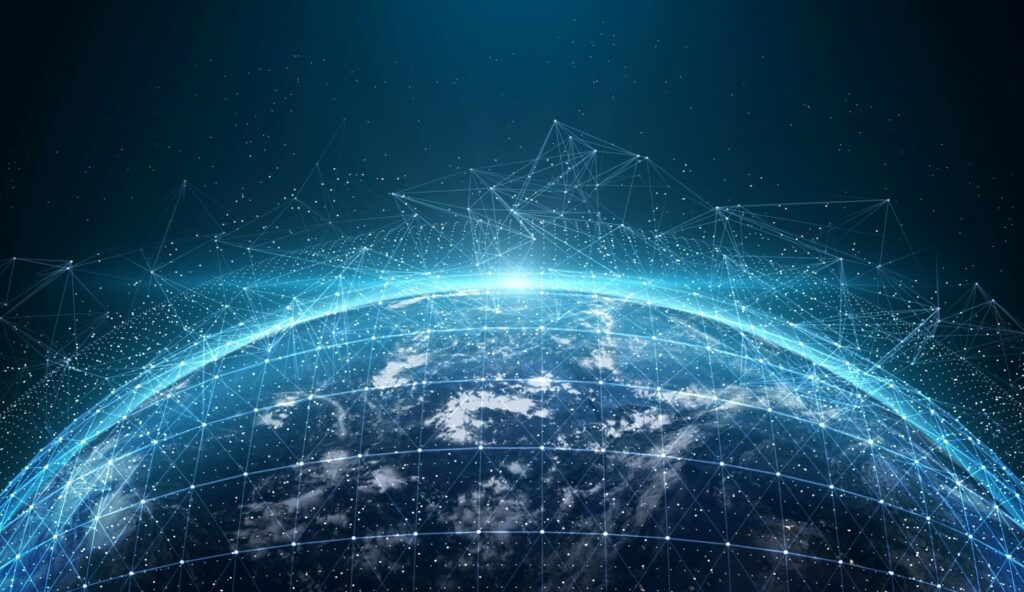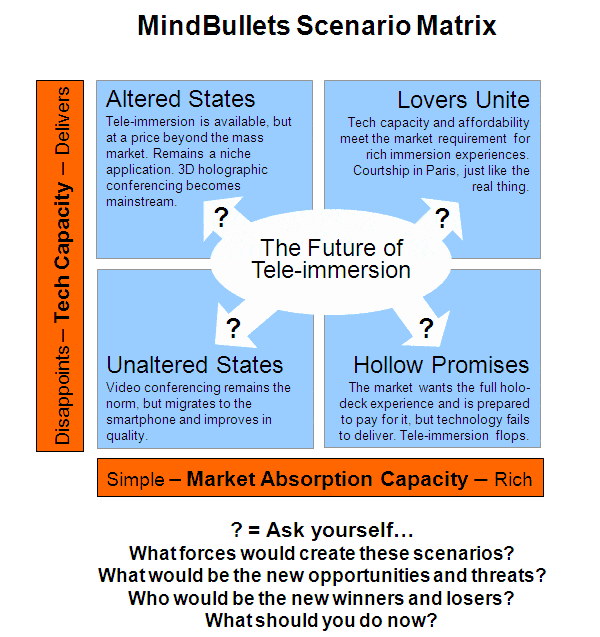
Long distance lovers hook up in cyberspace

Couple to wed after ‘teleporting’ to romantic Valentine date in Paris
- Dateline
- 15 February 2024
Justin and Britney are enjoying the afterglow of a wonderful night out in Paris. The evening started with a sunset cruise on a bateau mouche down the Seine, moved on to a spectacular show at the Moulin Rouge, followed by cosy nightclub dancing and finally ended in the honeymoon suite of the Ritz.
And yet Justin was still on location in New Mexico, and Britney is touring Australia. The date was made possible by the latest multi-channel tele-immersion system from TeleXperience, which allows two subjects to interact with each other and their environment as if they were right inside a live Google Earth iView.
“And because we beam the sensory signals from the location in real time, it’s authentic,” said Jacques Delport, president of TeleXperience. “If it’s raining in Paris, you get wet, and if your date has PMS, that’s a real problem for you.”
“It was the most wonderful night ever,” gushed Britney, “and when Justin popped the question, I just said yes!”
“It’s a bit like that old movie ‘The Matrix’,” said Justin from his VirtualMe trailer. “You know you can punch out, but it’s so real you don’t want to.”
Of course, the couple was not teleported to Paris – rather the sights and sounds of Paris were teleported to them, perfecting the illusion that they were there.
The next challenge for TeleXperience is to provide face-to-face meetings for world political leaders – on ‘neutral’ territory of course.
ANALYSIS >> SYNTHESIS: How this scenario came to be
“Beam me up, Scotty.” Who can forget those immortal words from Star Trek? Of course, the Transporter solved several problems for the starship Enterprise. Firstly it gave the directors a really futuristic device to get their characters into and out of interesting places and tight spots, with cool fading effects as the people disappeared or re-materialized. But perhaps equally important was the ability to visit alien worlds, and embark and disembark crew members at will, without having to go through the tedious expense of landing – several times per episode – a space ship that was obviously designed for warp speed cruising, and not surface parking.
The true allure of teleportation is the fact that it is the ultimate solution to the tedium of personal travel. Just as Concorde (or even TGV) would seem magical to a squire from the middle ages, so teleportation promises the ability to suspend the laws of time and space and traverse a physical distance at the speed of light.
Unfortunately, physical teleportation of people is unlikely ever to be a reality. But if Mohammed can’t realistically get to the mountain, then the mountain (or at least a reasonable facsimile) must be brought to Mohammed. The sights, sounds and feelings of the distant place can be instantly transported to the subject, using modern technology. This is the idea behind multi-person tele-immersion. A virtual-reality-experience video conference.
Virtual Reality, on the other hand, is a fairly mature technology, enabling one to interact with a virtual world. VR goggles and gloves give the user the ability to be immersed in the landscape and even interact with others, as in online games. However, these virtual worlds are pre-programmed computer objects, and have no link to the real changing world of a specific location. Tele-immersion seeks to actively record and transmit the real-time sensory experiences of the interactive location to the user. Once the real world, recorded digitally as in Google Earth, becomes a virtual environment you can explore in immersive 3D, then the illusion of being teleported there is complete.
2007: Socializing in another life
Second Life becomes the most popular online virtual world, with people from all over the planet meeting up to chat, socialize, even have work meetings. Strangely enough, many members of Second Life enjoy going to virtual night clubs and ‘dancing’, and even making out and cybersex are popular.
2009: 3D Holographic DVDs
Moving holograms make the interactive experience more real than ever. The auto-stereoscopic system consists of red, green and blue laser diodes, a liquid-crystal spatial light modulator and a projection lens. It generates slightly different images for the left and right eyes to produce the effect of natural three-dimensional vision.
3D movies and ‘natural’ 3D TV screens (requiring no stereoscopic specs) become popular all over again. Hungry for something novel, the entertainment world is embracing 3D in a big way.
2014: Enter the holodeck – the virtual reality home theatre
Researchers finally manage to broadcast moving holograms at a rate and quality level that allows the viewer to interact visually with the images in real-time. Unfortunately one can’t touch or feel them, but being immersed in the imagery and sound provides an unreal sense of reality.
Sony partners with Google to launch the VirtualMe system – a home theatre installed in your lounge that lets you walk around Google Earth Streetview, fly over Manhattan, or dive into the ocean.
2017: The smart body glove
Haptic technology turns to smart fabrics to create touchable holograms. Smart fabrics have millions of nano-scale sensors integrated into the cloth. A body suit of this material gets you really hooked up to the interactive experience. Now you can feel as well as see and hear your virtual environment, be it the blistering heat of the Sahara, or the bone-numbing cold of the Antarctic, all from the ‘comfort’ of your living room.
Meanwhile, the ability to read, decipher and stimulate brain activity patterns with non-invasive sensors reaches new heights. Now scientists can record taste, movement and visual experiences from the brain, and play them back to another person, tuned to the individual’s own brain-wave patterns.
2024: TeleXperience offers the full package
TeleXperience makes tele-immersion a reality, by prior arrangement of course. By providing the on-location ‘teleportation’ crew and sensory equipment, the experience is authentic. They even provide body doubles for the ‘contact sequences’. The system is pretty user-friendly. Subjects don a body glove containing millions of tiny bi-directional sensors woven into the fabric and slide into a ‘teleportation’ chamber reminiscent of ‘Altered States’. Direct stimulation of the cerebral cortex ensures that senses such as taste and movement are fully replicated.
“It’s part entertainment, part travel, part fantasy,” says Delport. “I can’t really describe it; you just have to experience it for yourself.”

Links to related stories
- Movie: The Lawnmower Man
- Multi-person tele-immersion over the internet - Brown University project
- Out of this world: A step towards 3D TV - The Economist 11 November 2004
- Reaching Through the Net to Touch - Wired News 3 July 2003
- Google Earth Dives Into The Deep Blue Sea - CBS News 2 February 2009
- Canadian boffins develop mindreader headband - The Register 10 February 2009
- MindBullet: GOOGLE EARTH WORLD'S SIXTH BIGGEST ECONOMY (Dateline: 7 June 2017, Published: 12 April 2007)
- MindBullet: SELL ME YOUR MEMORIES (Dateline: 19 September 2019, Published: 21 August 2008)
Warning: Hazardous thinking at work
Despite appearances to the contrary, Futureworld cannot and does not predict the future. Our Mindbullets scenarios are fictitious and designed purely to explore possible futures, challenge and stimulate strategic thinking. Use these at your own risk. Any reference to actual people, entities or events is entirely allegorical. Copyright Futureworld International Limited. Reproduction or distribution permitted only with recognition of Copyright and the inclusion of this disclaimer.